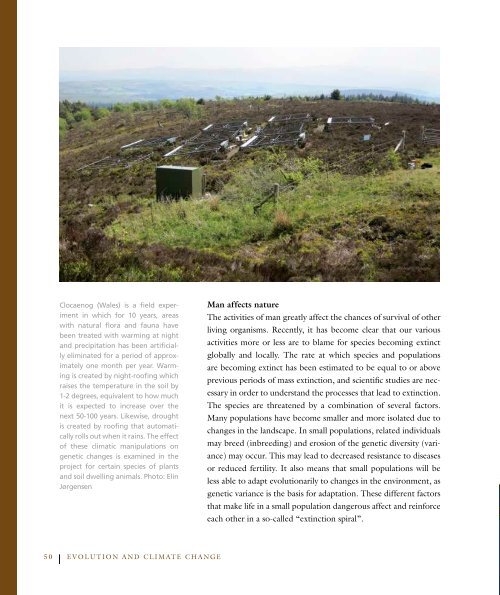Home to the skylark - The Velux Foundations
Home to the skylark - The Velux Foundations
Home to the skylark - The Velux Foundations
Create successful ePaper yourself
Turn your PDF publications into a flip-book with our unique Google optimized e-Paper software.
Clocaenog (Wales) is a field experiment<br />
in which for 10 years, areas<br />
with natural flora and fauna have<br />
been treated with warming at night<br />
and precipitation has been artificially<br />
eliminated for a period of approximately<br />
one month per year. Warming<br />
is created by night-roofing which<br />
raises <strong>the</strong> temperature in <strong>the</strong> soil by<br />
1-2 degrees, equivalent <strong>to</strong> how much<br />
it is expected <strong>to</strong> increase over <strong>the</strong><br />
next 50-100 years. Likewise, drought<br />
is created by roofing that au<strong>to</strong>matically<br />
rolls out when it rains. <strong>The</strong> effect<br />
of <strong>the</strong>se climatic manipulations on<br />
genetic changes is examined in <strong>the</strong><br />
project for certain species of plants<br />
and soil dwelling animals. Pho<strong>to</strong>: Elin<br />
Jørgensen<br />
Man affects nature<br />
<strong>The</strong> activities of man greatly affect <strong>the</strong> chances of survival of o<strong>the</strong>r<br />
living organisms. Recently, it has become clear that our various<br />
activities more or less are <strong>to</strong> blame for species becoming extinct<br />
globally and locally. <strong>The</strong> rate at which species and populations<br />
are becoming extinct has been estimated <strong>to</strong> be equal <strong>to</strong> or above<br />
previous periods of mass extinction, and scientific studies are nec-<br />
essary in order <strong>to</strong> understand <strong>the</strong> processes that lead <strong>to</strong> extinction.<br />
<strong>The</strong> species are threatened by a combination of several fac<strong>to</strong>rs.<br />
Many populations have become smaller and more isolated due <strong>to</strong><br />
changes in <strong>the</strong> landscape. In small populations, related individuals<br />
may breed (inbreeding) and erosion of <strong>the</strong> genetic diversity (vari-<br />
ance) may occur. This may lead <strong>to</strong> decreased resistance <strong>to</strong> diseases<br />
or reduced fertility. It also means that small populations will be<br />
less able <strong>to</strong> adapt evolutionarily <strong>to</strong> changes in <strong>the</strong> environment, as<br />
genetic variance is <strong>the</strong> basis for adaptation. <strong>The</strong>se different fac<strong>to</strong>rs<br />
that make life in a small population dangerous affect and reinforce<br />
each o<strong>the</strong>r in a so-called “extinction spiral”.<br />
Global climate change<br />
<strong>The</strong> entire world is facing <strong>the</strong> challenge of global<br />
climate change. <strong>The</strong> climate is a crucial determi-<br />
nant of which species are able <strong>to</strong> survive. Basically,<br />
a species is able <strong>to</strong> respond within 3 months of its<br />
environment having been changed: it may move<br />
(migrate) <strong>to</strong> new areas where <strong>the</strong> environment is<br />
better suited <strong>to</strong> its biology, or it may adapt <strong>to</strong> <strong>the</strong><br />
changes taking place in its current environment.<br />
If none of <strong>the</strong>se responses are possible, <strong>the</strong> species<br />
may become extinct.<br />
During previous periods of climate change, it<br />
may be assumed that <strong>the</strong> individual populations<br />
were <strong>to</strong> some extent able <strong>to</strong> find a suitable new<br />
environment, e.g. by migrating south or north.<br />
Today most species are “captured” in “nature is-<br />
lands” that are surrounded by a ‘hostile environ-<br />
ment’. <strong>The</strong> natural areas have largely been deter-<br />
mined and local populations may find it difficult<br />
<strong>to</strong> find new suitable areas, even if <strong>the</strong>y are able<br />
<strong>to</strong> migrate. This is why it is important <strong>to</strong> study<br />
how populations react <strong>to</strong> climate change and<br />
how <strong>the</strong>y adapt <strong>to</strong> e.g. higher temperatures. This<br />
knowledge will help us understand which genetic<br />
prerequisites must be fulfilled for adaption <strong>to</strong> a<br />
changing climate <strong>to</strong> succeed, how much time it<br />
takes, and which groups of animals and plants are<br />
particularly robust or fragile.<br />
Global warming? Graphics: NASA<br />
How do animals and plants respond <strong>to</strong> climate<br />
change?<br />
<strong>The</strong> climate is changing rapidly. Summers are warm-<br />
er and dryer and climatic fluctuations are becoming<br />
more extreme. This causes <strong>the</strong> living conditions for<br />
animals and plants <strong>to</strong> change. Climate change may<br />
lead <strong>to</strong> adverse living conditions for some species,<br />
while at <strong>the</strong> same time, some species, e.g. sou<strong>the</strong>rn<br />
species, may be able <strong>to</strong> thrive in nor<strong>the</strong>rn latitudes.<br />
Changes in <strong>the</strong> composition of species may also po-<br />
tentially affect species that are not directly affected<br />
by climate change and may, thus, influence <strong>the</strong> en-<br />
tire ecosystem network. Species of <strong>the</strong> biological<br />
community affect each o<strong>the</strong>r, and <strong>the</strong> extinction of<br />
one species may cause a cascade of changes that may<br />
lead <strong>to</strong> o<strong>the</strong>r species’ disappearing or multiplying.<br />
In this way, biological systems consist of a myriad<br />
of interacting elements and each element cannot be<br />
seen as standing alone. Interactions may e.g. be be-<br />
tween preda<strong>to</strong>rs and prey, hosts and parasites, flow-<br />
ers and pollina<strong>to</strong>rs or seeds and seed distribu<strong>to</strong>rs.<br />
New invasive or newly introduced species (flora/<br />
fauna pollution) may be caused by similar imbal-<br />
ances.<br />
This project focuses on whe<strong>the</strong>r species are able <strong>to</strong><br />
adapt evolutionarily and, if so, whe<strong>the</strong>r <strong>the</strong>y can<br />
adapt “quickly enough”. Evolutionary adaptation<br />
implies genetic changes in a species’ genetic ma-<br />
50 EVOLUTION AND CLIMATE CHANGE VILLUM FOUNDATION 51<br />
TECHNICAL AND NATURAL SCIENCES



